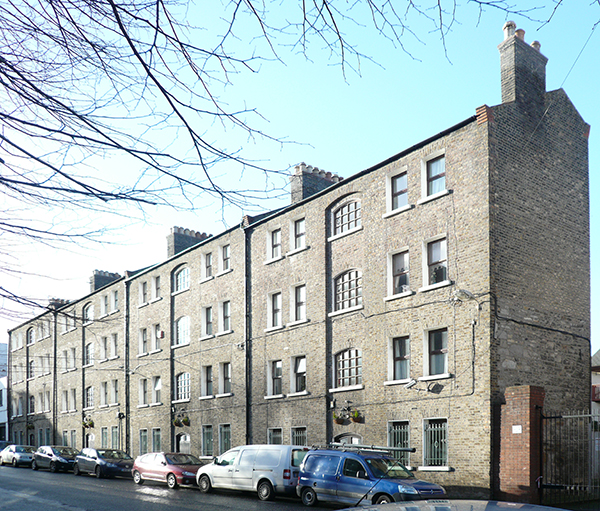Echlin Buildings
Published in Gems of Architecture, Issue 6 (November/December 2016), Volume 24Echlin Street, Dublin 8
By Ciarán Wallace
Echlin Buildings, off James’ Street, is Dublin’s first purpose-built block of flats, opened in March 1878. The location of these homes for workers reflected the industrial character of a district that included breweries, distilleries and a major wharf on the Grand Canal. The Buildings were commissioned by the Dublin Artisan Dwelling Company (DADC), founded in 1876 to tackle the city’s chronic housing problems, albeit for a profit. Under its chairman, Sir Arthur Guinness (1840–1915), the DADC engaged two prominent architects on its initial projects, Thomas Newenham Deane (1827–99) and Thomas Drew (1838–1910). Deane left after completing the first two projects in Echlin Street and Dominick Street Upper.
In 1876 the DADC leased a site from the Grand Canal Company at £15 per annum. Deane’s initial plan, to erect twelve cottages at a cost of £1,000, was scrapped in favour of a proposal to construct a block of 30 flats for £2,820, substantially increasing the rental income. Additional items that the builder, John Cunningham, felt were needed brought the total cost to £3,092, or £103 per unit. Each flat included a kitchen, sitting room and two bedrooms, accommodation that far exceeded the standard endured by so many residents in Dublin’s squalid tenements.

Above: Echlin Buildings survive as a monument to the mid-Victorian concept of philanthropy as a commercial concern. (Norman Mongan)
Echlin Buildings appear as four adjoining, symmetrically fronted blocks faced with yellow brick. The internal arrangement of each block is reasonably clear from the street, with a central stairwell, expressed by a full-height recess with camber-headed window openings, giving access to flats on each side. With the DADC keen to keep costs down, the Buildings show a minimum of superfluous ornamentation and are functional, if not severe, in appearance.
Rents on the new flats ranged from 2/6 to 5/6 per week. At first not all of the flats were occupied, and some tenants moved out after only a few months: it appears that even in a city of overcrowded tenements, clean and modern housing did not automatically attract tenants. Price was an important consideration and the typical casual labourer could not afford the weekly rent, payable in advance. But for those who could afford them, the Echlin Buildings flats were a marked improvement in living conditions, as were the DADC’s Dominick Street Upper flats (also known as Temple Buildings), completed the following May.
The folk history of Dublin’s slums presents all tenement-dwellers as equally poor. The Echlin Buildings prove that this was not the case. What might appear to the modern observer to be basic housing for humble labourers were in fact well-built and properly maintained homes for the artisan élite. The flats became a symbol of comparative prosperity and social status amongst the city’s working classes.
Ultimately, however, Dubliners who could afford to move out of tall, overcrowded slums did not want to relocate to other tall, multi-tenanted buildings with shared hallways and yards, no matter how architecturally designed, newly built and centrally located. Consequently, the DADC phased out its plans for tenement blocks in the 1880s and instead began to focus on terraces of single-storey cottages and two-storey houses. But the Echlin Buildings survive as a monument to the mid-Victorian concept of philanthropy as a commercial concern: a social experiment that addressed tenants’ needs but not necessarily their wants.
Ciarán Wallace lectures in Irish history and Irish studies at DCU, Mater Dei Campus. Series based on the NIAH’s ‘building of the month’, www.buildingsofireland.com.
















